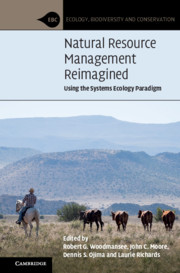Book contents
- Natural Resource Management Reimagined
- Ecology, Biodiversity and Conservation
- Natural Resource Management Reimagined
- Copyright page
- Contents
- Contributors
- Preface
- 1 The Systems Ecology Paradigm
- 2 Environmental and Natural Resource Challenges in the Twenty-First Century
- 3 Evolution of Ecosystem Science to Advance Science and Society in the Twenty-First Century
- 4 Five Decades of Modeling Supporting the Systems Ecology Paradigm
- 5 Advances in Technology Supporting the Systems Ecology Paradigm
- 6 Emergence of Cross-Scale Structural and Functional Processes in Ecosystem Science
- 7 Evolution of the Systems Ecology Paradigm in Managing Ecosystems
- 8 Land/Atmosphere/Water Interactions
- 9 Humans in Ecosystems
- 10 A Systems Ecology Approach for Community-Based Decision Making
- 11 Environmental Literacy
- 12 Organizational and Administrative Challenges and Innovations
- 13 Where to From Here? Unraveling Wicked Problems
- Index
- References
11 - Environmental Literacy
The Systems Ecology Paradigm
Published online by Cambridge University Press: 25 February 2021
- Natural Resource Management Reimagined
- Ecology, Biodiversity and Conservation
- Natural Resource Management Reimagined
- Copyright page
- Contents
- Contributors
- Preface
- 1 The Systems Ecology Paradigm
- 2 Environmental and Natural Resource Challenges in the Twenty-First Century
- 3 Evolution of Ecosystem Science to Advance Science and Society in the Twenty-First Century
- 4 Five Decades of Modeling Supporting the Systems Ecology Paradigm
- 5 Advances in Technology Supporting the Systems Ecology Paradigm
- 6 Emergence of Cross-Scale Structural and Functional Processes in Ecosystem Science
- 7 Evolution of the Systems Ecology Paradigm in Managing Ecosystems
- 8 Land/Atmosphere/Water Interactions
- 9 Humans in Ecosystems
- 10 A Systems Ecology Approach for Community-Based Decision Making
- 11 Environmental Literacy
- 12 Organizational and Administrative Challenges and Innovations
- 13 Where to From Here? Unraveling Wicked Problems
- Index
- References
Summary
Ecosystem science and the systems ecology paradigm co-evolved starting in the late 1960s within the milieu of substantial research funding from the US National Science Foundation-supported US International Biological Program (IBP). Nationally, educational programs focusing on ecosystem structure and functioning, and mathematical modeling, were slow to develop except at Colorado State University (CSU). There, leaders in the Natural Resource Ecology Laboratory (NREL) and the Department of Range Science (DRS) established internationally recognized interdisciplinary programs and outreach in basic and applied ecosystem science and systems ecology. Operating from the sound research base within a major Land Grant University (CSU), the NREL, with IBP funding, supported many graduate students housed in the academic DRS. As the systems ecology approach expanded, other ecosystem-focused research programs developed, and graduate students entered other academic departments. Outgrowths from the early diffused educational training were innovative cross-departmental and cross-college programs addressing the systems ecology paradigm. Recently, a new Department of Ecosystem Science and Sustainability was established housing both graduate and undergraduate programs. As formal academic training developed on-campus, environmental literacy efforts were developed, including: training programs for K-12 students and teachers; online distance education programs; Citizen Science training; and numerous institutes, short courses, and workshops.
Keywords
- Type
- Chapter
- Information
- Natural Resource Management ReimaginedUsing the Systems Ecology Paradigm, pp. 335 - 352Publisher: Cambridge University PressPrint publication year: 2021



